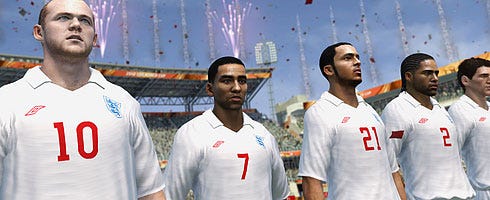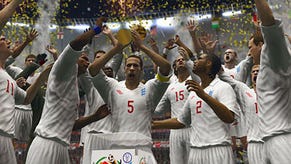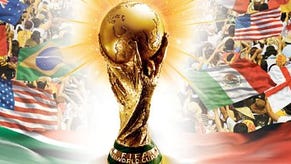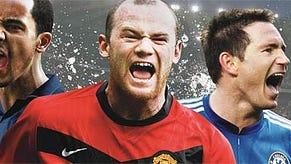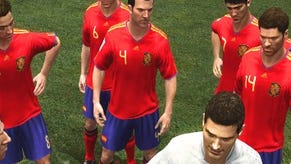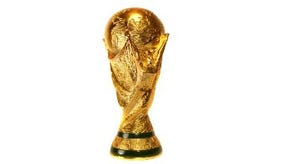Impressions: Will FIFA World Cup honestly be worth buying?
All text by Joe Anderson.
EA is often criticised for releasing an alternative version of FIFA halfway through the year, with many shouting "cash-in". With 2010 FIFA World Cup South Africa releasing at the end of April it seems likely we're in for another round of accusations, but are they really justified this time out?
VG247 visited EA in Guildford, UK, last week to get to grips with FIFA's latest version. Having spoken to the game's producer, it's obvious the team believes it has an excellent product; after spending some time with it, it's clear it has a point.
As soon as you see FIFA World Cup 2010 it's obvious things have changed from FIFA 10. Producer Simon Humber explained to us that EA tried to create a “Carnival of Football” experience for the World Cup edition, and it seems to have succeeded. The stadia are filled with confetti, fireworks, camera flashes and fans, who add plenty of atmosphere as they dance through the match.
Ambience isn't the only factor to get its tempo upped. Graphics have had a major overhaul from FIFA 10, and from the comparison shots we were shown there really is a huge difference. A main focus has been on creating more effective lighting, which now shines off both the player and the pitch, making the whole experience more inviting and realistic.
Every aspect of the overall "feel" package has been touched. Players' celebrations are a key point. Whereas before the camera would slowly zoom in, now goal-winning sequences fill the screen, allowing you to see the joy and emotion on the player's face.
Sod the pretties, though: there have been some significant gameplay additions to FIFA World Cup. The developers were looking to make the whole experience more accessible, they told us, and therefore added the “Dad Pad”, which is basically two-button control. This allows players with a lack of experience to pick up the controller and play straight away without having to learn the traditional button lay-out.
The other big change is added realism in penalties. A Composure meter has been added to indicate pressure, which increases or decreases in size depending on the situation. It'll be far easier for a player to score a penalty in the early rounds than, for example, to win the Cup with the last penalty.
Another new penalty feature is a twitch mechanic that allows you to trick the goalkeeper with a last minute direction change.
On the defensive side, goalkeepers now have the ability to move across the line, waving their arms around in the air in order to put the penalty taker off his shot. The changes to the penalties are fantastic, and although the producer wouldn’t confirm it we'd expect to see this lot feature in future FIFA games.
Although most of the changes would be hard to see without studying the game at close quarters, this cannot be said of the general gameplay which feels even more fluid than before. Improvements mainly come down to the little tweaks; for example, players now take the ball with their chest while on the move and they can even pass the ball in this way. Plenty of new tricks have also been added, all of which combine to make for a better and faster-flowing match. It's a better game on quick impressions. Little doubt of that.
Other interesting changes include altitude effects, which will cause the stamina of teams used to low-level play to suffer.
Overall, we are told that there are over 100 enhancements over FIFA 10, which is a pretty impressive statistic.
The main event
Anyone looking for an authentic tournament experience won't be disappointed. All 199 teams who entered the tournament are available for play. As well as all the traditional play features you'd expect, you can take any team through offline modes such as the Story of Qualifying, which allows you to play in real-life scenarios in order to change history, so if you're so inclined you can go back and change England’s lone Group 6 defeat by Ukraine. Amazing.
The Story of the Finals is another "real-life" mode, which adds matches based on true scenarios during the finals. They'll be added as DLC by EA as the real tournament progresses.
Then there's Captain your Country mode. In a similar vein to Be A Pro, this sees you start at the bottom of the football ladder and try to work your way up to captain of your international team. The overall objective is to lead your team to World Cup glory and therefore take you place at the front of the queue when lifting the trophy. This mode can be played with up to four player’s offline, allowing you to compete with your friends for the precious captain's armband.
FIFA wouldn’t be FIFA without everything being polished to buggery, so, as you would expect, all the kits, balls, teams and menus are well presented.
World Cup mode includes all-new information to keep you up to date, giving you news about your team's popularity and how they're doing on the Nation and Gamer online leaderboards.
The mode which EA's hoping will keep the hardcore playing after the World Cup is the new World League Ladder. This is a new ranking system based on ten divisions with added promotion and relegation. The season in the World League Ladder consists of ten games and a four-round knockout cup, with ranking points awarded based on your success each season.
Bottom line: is FIFA World Cup 2010 worth splashing out on? Although the game may not have changed much at first glance, once you look a bit closer at the new modes, changes to gameplay and the all-new accessibility for the less experienced, you have to say that it does have the potential to be best FIFA yet. Watch for the reviews in a few weeks.
2010 FIFA World Cup South Africa releases for PS3, 360 and PSP on April 30.
